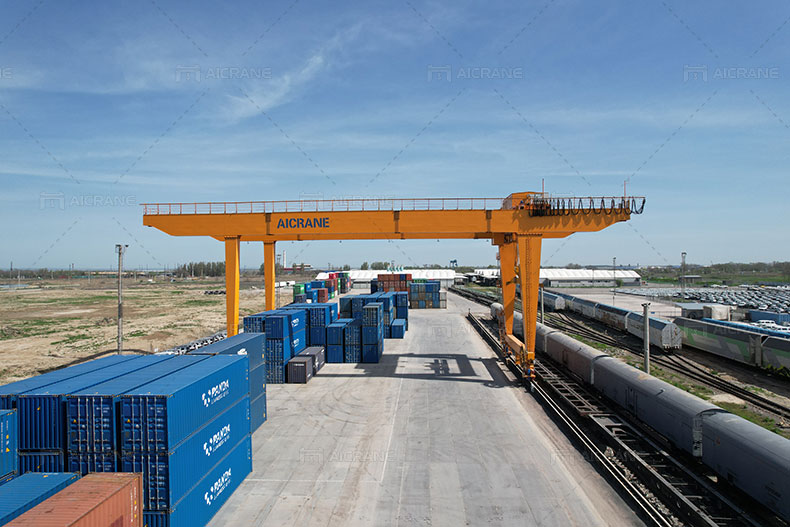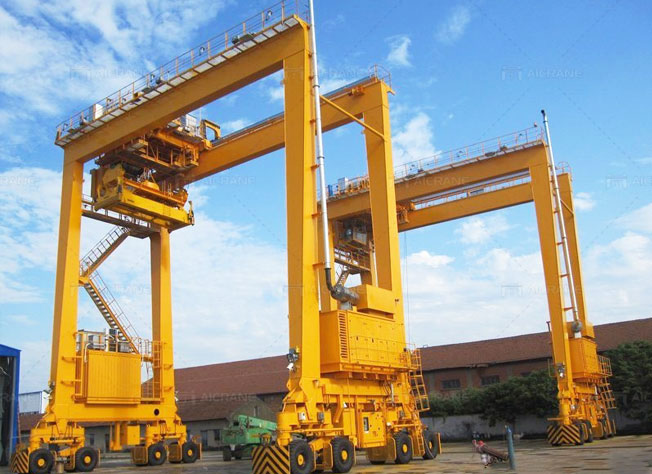Container terminals play a crucial role in global logistics, requiring efficient equipment for handling large volumes of cargo. Among the most widely used cranes in container handling are Rail Mounted Gantry (RMG) cranes and Rubber Tyred Gantry (RTG) cranes. Both have their advantages and are suited to different operational environments. If you are considering investing in a gantry crane for your terminal, understanding the differences between RMG and RTG cranes will help you make an informed decision.

1. Overview of RMG and RTG Cranes
Rail Mounted Gantry (RMG) Cranes
The RMG crane is fixed on rails and operate within a designated area, typically in large container terminals, intermodal yards, and rail freight depots. These cranes are electrically powered and are known for their efficiency, automation capabilities, and high stacking density.
Rubber Tyred Gantry (RTG) Cranes
RTG cranes, on the other hand, are mobile gantry cranes fitted with rubber tires, allowing them to move freely within the terminal. They offer flexibility in container stacking and are often used in smaller terminals or where mobility is crucial.

2. Key Differences Between RMG and RTG Cranes
a. Mobility and Flexibility
- RMG Cranes: Operate on fixed rails and are restricted to a specific area. They are ideal for dedicated container stacking yards with high throughput.
- RTG Cranes: Feature rubber tires and can move between different container rows or sections of the terminal. The RTG crane provides operational flexibility, making it suitable for terminals with changing layouts.
b. Power Source and Energy Efficiency
- RMG Cranes: Electrically powered, leading to lower operating costs and reduced environmental impact. They are highly energy-efficient compared to diesel-powered equipment.
- RTG Cranes: Traditionally powered by diesel engines, but hybrid and electric RTGs are now available to improve energy efficiency and reduce emissions.
c. Lifting Capacity and Productivity
- RMG Cranes: Generally have higher lifting capacities and faster container handling speeds. Their automation capabilities further enhance productivity.
- RTG Cranes: While capable of handling heavy loads, they are often slightly slower than the rail mounted container gantry crane due to their reliance on manual operation and mobility constraints.
d. Automation and Technology Integration
- RMG Cranes: More commonly integrated with automation technologies such as remote control, automatic stacking, and IoT-based monitoring systems. Ideal for smart terminals aiming for higher efficiency.
- RTG Cranes: Typically require more manual operation but are increasingly incorporating automation technologies to enhance performance.
e. Space Utilization and Terminal Layout
- RMG Cranes: Support high-density stacking, making them suitable for terminals with limited space.
- RTG Cranes: Require wider lanes for movement, reducing overall stacking capacity compared to RMG setups.
f. Maintenance and Operational Costs
- RMG Cranes: Require specialized track maintenance but have lower fuel and maintenance costs due to their electric power system.
- RTG Cranes: Diesel-powered RTGs have higher fuel and maintenance costs, while electric and hybrid versions offer cost savings.
3. Choosing the Right Crane for Your Terminal
When to Choose RMG Cranes
- Your terminal handles a high volume of containers and requires automated solutions for increased efficiency.
- Space is limited, and high-density stacking is a priority.
- You want to reduce operational costs by using fully electric gantry crane.
- Your facility is part of a large-scale intermodal or railway logistics hub.
When to Choose RTG Cranes
- Your terminal requires flexible container handling and the ability to move cranes between different areas.
- Your operations are dynamic, and you need equipment that adapts to changing storage layouts.
- Initial investment budget is a key factor, as RTG cranes typically have lower upfront costs compared to RMG cranes.
- You operate in a port or terminal with a mix of container types and require mobile stacking solutions.
4. Cost Considerations
- Initial Investment: RMG cranes typically cost more upfront due to their advanced technology and fixed infrastructure requirements.
- Operating Costs: RMG cranes have lower running costs due to their electric power source, while traditional RTGs incur higher fuel costs unless converted to hybrid or electric versions.
- Maintenance Costs: RTG cranes often require more frequent maintenance due to their mobile nature, while RMG cranes need occasional track maintenance but have fewer moving parts prone to wear and tear.
5. Future Trends and Innovations
The container handling industry is shifting towards greener and more automated solutions. Hybrid and electric RTG cranes are becoming more popular as terminals look for ways to reduce emissions. Meanwhile, smart automation and AI-driven control systems in RMG cranes are enhancing productivity and safety in high-volume terminals.
Conclusion
Both RMG and RTG cranes offer unique advantages, and the best choice depends on your terminal’s specific needs. If efficiency, automation, and high stacking density are your priorities, RMG cranes are the better option. However, if flexibility, mobility, and adaptability are more critical, then RTG cranes may be the right choice.
Understanding your operational requirements, budget, and long-term goals will help you determine which crane type best suits your terminal, ensuring maximum efficiency and cost-effectiveness in container handling operations.